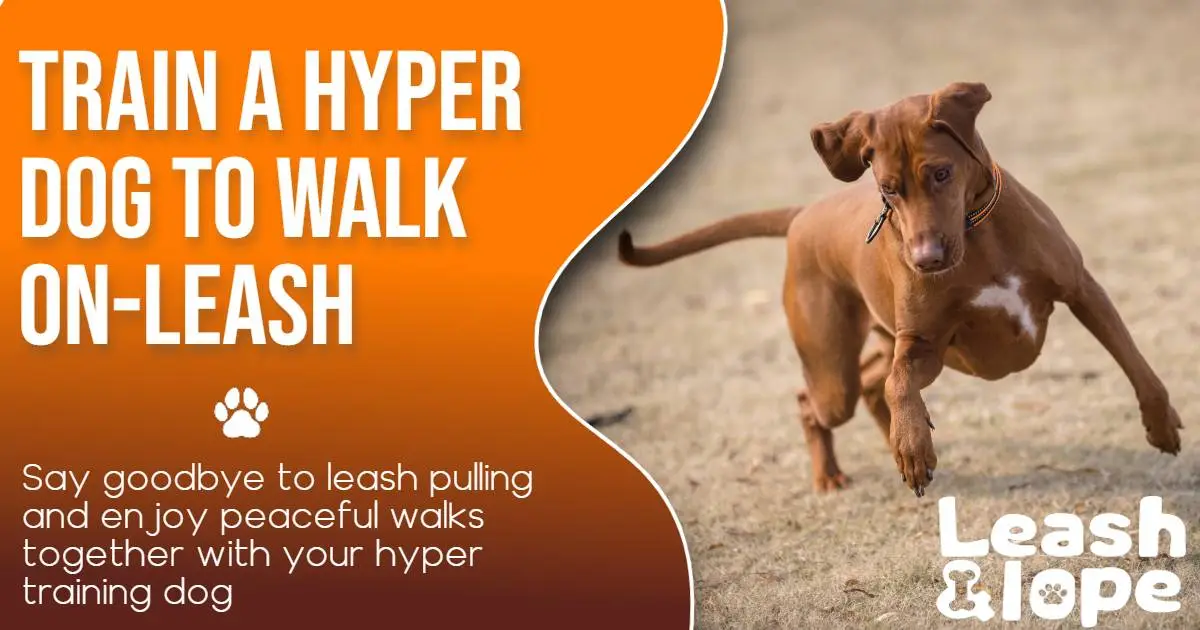Train a Hyper Dog to Walk on a leash can be a tough challenge, but fear not because we’re here to guide you in every step of this process. In this comprehensive article, we’re going to explore a plethora of techniques, tips, and tricks that will help you transform your furry tornado into a well-behaved walking companion.
We’ll start by knowing about the reasons for the hyperactivity of a dog, leading to an understanding of the importance of leash training. From there, we’ll delve into the nitty-gritty details of teaching your dog proper leash manners, including loose leash walking, basic obedience commands, and handling distractions. It’ll help your dog in tackling common challenges experienced during this training such as pulling, lunging, and overexcitement. We’ll also discuss the significance of positive reinforcement and reward-based training methods to encourage good behavior. Moreover, we’re gonna discuss how exercises can be beneficial in helping your dog manage his hyperactivity in a better way.

So grab a cup of coffee (or maybe some doggy treats), sit back, and get ready to embark on this incredible journey towards leash-walking success. Together, we’ll conquer those chaotic walks and turn them into enjoyable adventures that strengthen the bond between you and your four-legged friend.
What’s the Reason Behind the Hyperactivity of a Dog?
Briefly explaining, hyperactivity in dogs can be due to physiological and pathological reasons.
Hyperactivity resulting because of pathological reasons is like ADHD which is seen in humans. If your dog experiences this then it’s quite necessary to have him checked by veterinary staff.
Some studies indicate that a dog’s early life experiences, including socialization during puppyhood, impact their behavior. Insufficient socialization at this crucial stage can result in anxiety and hyperactivity.
Physiological hyperactivity is quite common and a trainer will be able to help out in this case.
Since this article deals with the techniques helpful in train a hyper dog to Walk On-Leash only a brief explanation of this medical aspect is given here. Symptoms associated with both of these types can be found here.
Some studies suggest that dog breeds, like Border Collies and Jack Russell Terriers, are naturally more hyperactive due to their genetics.
9 Easy Ways to Train a Hyper Dog to Walk On-Leash
Research has demonstrated that proper training and socialization can significantly reduce hyperactivity in dogs

When it comes to training a hyperactive dog, it needs consistency and patience. The tips and tricks mentioned below can help you in this regard:
Some studies emphasize the importance of individualized training plans for hyperactive dogs. What works for one dog may not work for another.
1. Choose the Right Equipment:
When it comes to training those energetic pups, first choose the right leash and harness. Attach the leash to the harness.
A good leash will give you control without causing discomfort to your doggo. Look for one with a secure clip and adjustable length, so you can adapt it to different situations. As for the harness, opt for one that distributes the pressure evenly across the chest or back, rather than just around the neck. This helps prevent any strain or injury during walks.
With the right gear, you’ll be able to guide them smoothly through their training routine, keeping them safe and happy.
2. Address hyperactivity:

Exercising your hyper dog before leash training is quite beneficial. It helps in a bunch of ways. First off, it helps burn off some of that excess energy they’ve got going on, making them more focused and attentive during the training session. Think of it as tiring out those zoomies so they can actually listen to you.
See Exercise alternatives to running your dog
Secondly, exercise helps to stimulate their mind and body, which can improve their overall behavior and make them more receptive to learning. It’s like getting their brain gears turning and ready for action.
And lastly, a tired pup is usually a happier pup. When they’ve had a chance to run around and play, they tend to be more relaxed and content. This positive state of mind sets the stage for successful training because they’re in a better mood and more open to cooperating.
So, imagine it as a pre-training ritual where you take your doggo for a fun-filled adventure, let them stretch their legs, and get those endorphins flowing. Then when it’s time to hit the pavement with the leash, they’ll be in the right mindset to strut their stuff alongside you.
In some cases, medication may be recommended by veterinarians to help manage severe hyperactivity, especially when it is related to underlying medical issues or extreme anxiety.
3. Basic Obedience Demands
Practicing those basic obedience commands is like laying down the foundation for a smooth leash-walking experience with your hyperactive pup. When you work on commands like “sit,” “stay,” and “heel,” you’re not only teaching them important skills but also establishing yourself as the pack leader.
By practicing these commands, you’re teaching your furry friend impulse control and focus. They learn to listen to your cues and understand that good things come from following your lead. This helps them stay calm and attentive during walks, even when their hyper side kicks in.
For example, when you ask your dog to sit before crossing the street or wait for your signal to start walking again, it reinforces their self-control and keeps them safe.
4. Be the Leader to Train a Hyper Dog
Walking in front of a dog creates a sense of leadership for you, which makes the dog more comfortable and obedient. To do this, you need to make sure the dog understands that you are in charge. Therefore, instead of walking behind the dog, walk in front of him.
5. Don’t keep the leash too loose for Hyper Active Dog
In general, a loose leash can make the dog more excited. Keeping the leashless loose can actually be helpful when training a hyperactive dog. Here’s why:
When the leash is too loose, it gives your hyperactive pup more freedom to pull and go wherever it pleases. Keeping the leash slightly taut, helps you maintain better control over their movements. This way, you can guide them and redirect their attention when needed.
See how to train your dog to walk off leash
Having a firmer grip on the leash allows you to communicate with your dog more effectively. You can give gentle corrections or cues to help them stay focused and calm during walks. It’s all about finding that balance between control and comfort for both of you.
6. Giving corrections
Now that you’ve kept the leash slightly more taut, start walking with your dog. Make sure that you’re leading your dog and that he’s following you. This way he’d know that you’re the leader and he has to follow your commands.
As you’re walking your dog, pull the leash sideways if your dog starts hyperactivity. Pulling the leash upwards can be a bit harsh. It can put pressure on their neck and can cause the dog to become more anxious or fearful. Pulling the leash sideways can be a gentler way to redirect the dog’s attention and correct his behavior without causing stress or anxiety. You can also verbal cues to assist in correcting their behavior.
7. Positive Reinforcement
Positive reinforcement is like giving your hyperactive pup a pat on the back. When you reward good behavior with treats, praise, or even a belly rub, it helps reinforce that behavior and encourages them to repeat it. It’s all about creating a positive and rewarding environment for your furry friend.
A 2013 study in the Journal of Veterinary Behavior found that positive reinforcement-based training was more effective than punishment-based techniques in reducing hyperactivity and improving behavior in dogs.
8. Consistency, Patience &, Routine
As you start training your dog, it’s quite important to stay consistent and patient. It’s equally important to maintain a routine. Consistency means sticking to a routine and using the same commands or techniques every time. This helps your pup understand what’s expected of them and reduces confusion.
Patience is crucial because training takes time and effort. It’s important to remember that your furry friend won’t become a well-behaved angel overnight. So, stay consistent, be patient, and celebrate even the tiniest progress along the way.
Routine is all about establishing a regular schedule for training sessions, exercise, and feeding. Dogs thrive on predictability, so having a consistent routine helps them feel secure and focused. By sticking to a routine and being consistent in your approach, you’ll provide structure and clarity for your hyperactive pup, making the training process smoother and more effective.
9. Gradually Increase the Distractions:
Gradually increasing distractions is like turning up the volume on your dog’s training playlist. By starting in a calm and controlled environment and then slowly introducing distractions, you’re teaching your hyperactive pup to stay focused even when there’s a lot going on. It’s like building their concentration muscles.
So, whether it’s practicing commands at home with some background noise or taking them to a park with more stimuli such as people and other dogs, the key is to take it step by step and give them the chance to adapt and succeed.
Conclusion: Train a Hyper Dog
Train a Hyper Dog to Walk On-Leash got more energy than a lightning bolt at a disco party can be a wild ride.
As you start the training, be prepared for your pup to do their best impersonation of a kangaroo on a pogo stick. But fear not! The techniques mentioned in this article will certainly help you. And remember, patience is key here. Rome wasn’t built in a day, and neither will your dog’s leash-walking skills. You should also seek professional help if needed.
While you’re train a hyper dog to walk on leash, celebrate every small victory along the way and always end each training session on a positive note. With time, love, and plenty of treats, your hyperactive dog will become a leash-walking champ, making your outdoor adventures more enjoyable for both of you. So strap on your running shoes and get ready to embrace the chaos and cuteness that come with training your hyperactive furball. Get ready to strut your stuff together, my friend!

Dr. Haider is a general doctor with a unique level of connection to our four-legged friends. He is a valued contributor to our Website (Leash and Lope). Dedicated to providing accurate to dog owners in understanding and caring for their lovely pets.

